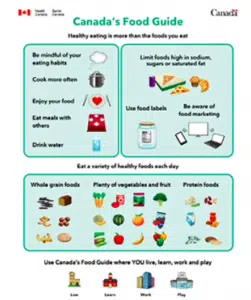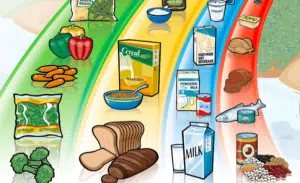Health Canada is preparing to release a revamped version of Canada’s Food Guide, which has not been updated since 2007.
The 2019 guide is expected to bring major changes including a different look and a recommendation to rely on plants as a source of proteins instead of meat and dairy.
The new version is set to eliminate the “milk and alternatives” group from the previous guide, and instead list some dairy products under the revised “protein foods” category.
From milk and cheese to kale and seeds
The elimination of the “milk and alternatives” category has caused concern to Canadians as well as to the dairy industry.

Graphic of a draft version of the revised food guide shown to focus groups. Image shows the elimination of the dairy food group. Photo: Health Canada via Earnscliffe Strategy Group
Sandra Venneri, local nutritionist and owner of Nutrition Bites, believes Health Canada’s decision to eliminate dairy as a food group was not done as a way to call those foods unhealthy, but to make people more aware that the same nutrients can be found in other foods. “What [Health Canada] is saying is: ‘hey, by the way, you don’t have to consume dairy if you don’t want to, you can actually get those nutrients from the other three groups,’” she said.
From Venneri’s experience in nutrition consulting the switch in emphasis from dairy to plant-based foods made sense. “I think Health Canada is trying to reflect what the public wants… The truth is a lot of people are consuming alternative dairy products anyways – whether it’s because they’re lactose intolerant or because they follow a certain lifestyle,” she said. “There are plenty of ways of getting calcium and protein that don’t involve dairy, it’s just that some people aren’t aware of that,” Venneri added.
Saying goodbye to the traditional rainbow

Cover of the last edition of Canada’s Food guide featuring the rainbow layout. Photo: Health Canada
Venneri suggests that although content is crucial, visuals play a big role in understanding nutrition.
The elimination of the traditional rainbow format of the food guide may cause the new guide to be a bit more difficult to navigate, especially when using it as a teaching tool in schools and daycares
“I’m sad to see the rainbow go. It’s very helpful, especially when teaching younger people. Having things colour-coded makes it easier to understand,” she said.
A holistic approach
Despite the changes, Venneri is praising Health Canada for encouraging “mindful” eating.
“It’s on the front page this time! That’s progress. They’re talking about mindful eating – taking time to eat, doing it when your body asks you and not when the clock tells you – and they’re talking about the importance of looking at food labels. These are things that will help people,” she said.
“In my opinion, getting away from the numbers [of daily calorie intake, servings per day] and developing a holistic approach to nutrition is going to be beneficial,” she added.
Health Canada says the new guide will be available within the first few months of the year.




